Garden tractors are cheap, fun pathways to the vintage-vehicle hobby
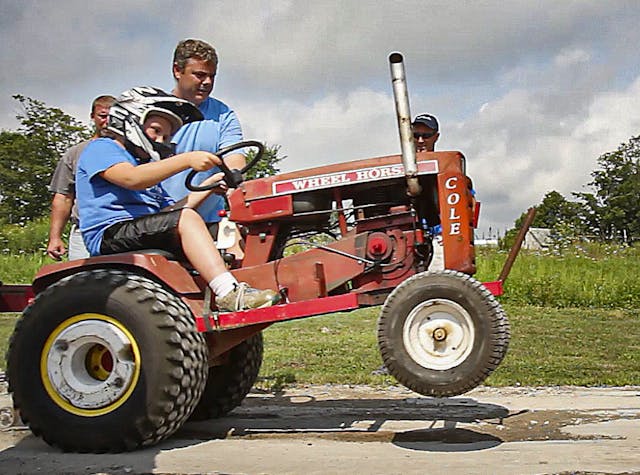
We hear it all the time: Getting kids involved in the classic car hobby is tougher than ever. How do you battle the high price of entry, especially when cost of upkeep, registration, insurance, and fuel incur their own demands?
Years ago, you’d have pointed your young classic vehicle fans to vehicles that existed on the margins: Four-door sedans and hardtops, station wagons, off-brand or weird stuff. But even these corners of the hobby have found an audience now, and the quality of collector car you can easily find for under a couple grand is pretty bleak.
There’s hope! Consider a fun, interesting, and darned useful wing of the collector vehicle marketplace that comparatively few people have explored: Garden tractors.
Look no further than your local Facebook Marketplace ads and you’ll find a garden tractor for sale that afford with returnable can money. Larger tractors like the Ford 8N have a passionate audience, but they do take up a lot of space, and they’re not cheap any longer. So, as Volkswagen used to say, think small.
Garden tractor enthusiasts prize their workhorses for their utility, but there are also contingents of fans that are using them for pulling competitions and for racing.
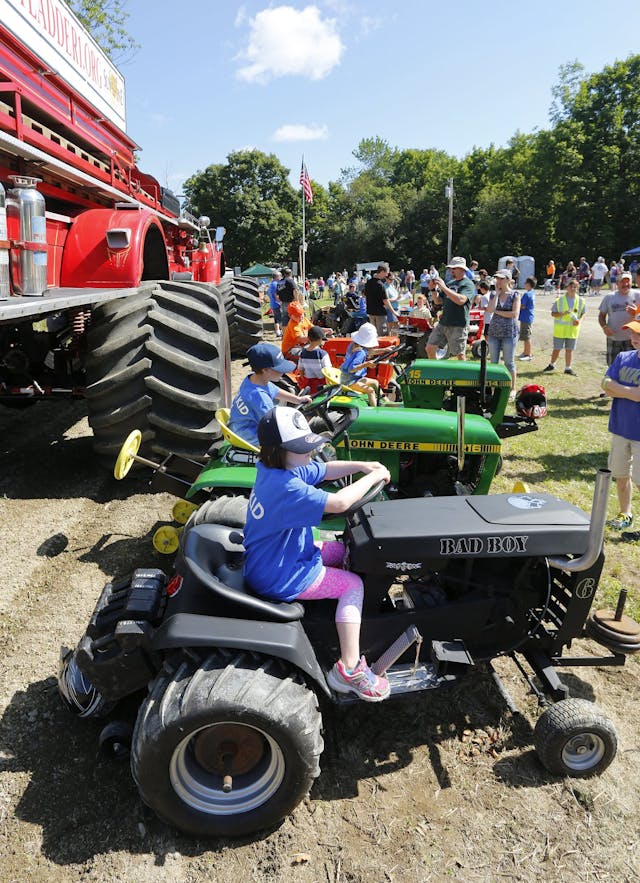
Lawn tractor or garden tractor?
You may not think so, but there is a difference between a lawn tractor and a garden tractor. Lawn tractors are more or less lawn mowers with a deck. They might have a bagger attachment on later versions, but their primary purpose is cutting the grass.
A garden tractor may indeed have a cutting deck, but it is also suitable for a range of attachments, from snowplows to snowblowers, and some might even have hydraulic buckets, three-point hitches, or PTO (power take-off) provisions for a wide range of light implements.
David Bradley and the garden tractor in America
You can’t talk about garden tractors—or any other kind of home implement from this period—without discussing David Bradley. Bradley was a manufacturing powerhouse at the turn of the 20th century, in the brick, lumber, and farm machine trades. In 1884 he purchased a plow manufacturing company, bought out his partner, and launched the David Bradley Manufacturing Company. In 1895 Bradley relocated the outfit to North Kankakee, Illinois, which was renamed Bradley City (shortened to Bradley by 1896) in his honor.
The bigtime hit in 1910, when he sold his manufacturing company to Sears, Roebuck and Company. For decades after, all of the home improvement equipment that Sears, Roebuck and Company sold was under the aegis of David Bradley: Lawnmowers, saws, utility trailers, rototillers, everything. Before there was Craftsman, there was David Bradley.
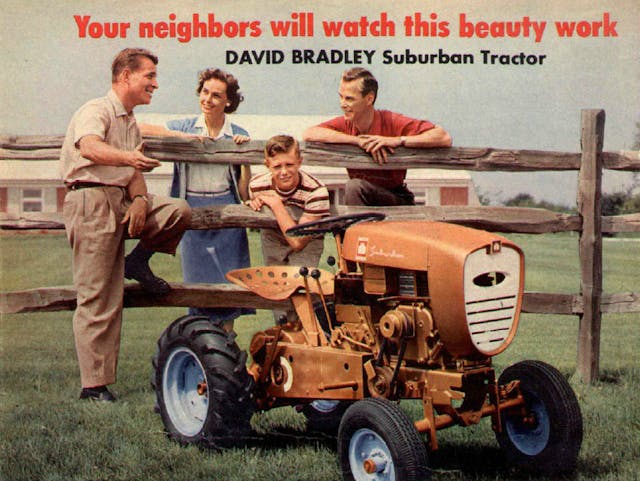
The David Bradley line of products included a garden tractor in 1958, and the company quickly became the world’s largest manufacturer of these little dynamos. In 1962, the David Bradley Manufacturing Company and the Newark Ohio Company merged under the latter’s name. Two years later, the Newark Ohio Company merged with the Geo. D. Roper Corporation, which went off producing its own brand of products, as well as those for Sears.
The Golden Era of garden tractors
Garden tractors really hit their stride as Americans pushed out from the cities into the suburbs and beyond. Wheel Horse began offering its small Ride-Away garden tractor as early as 1947, hitting its stride in the mid-1950s.
Based on the success of Wheel Horse and David Bradley, manufacturers like John Deere and Cub Cadet hit the scene in the early 1960s as the true golden era of the garden tractor really took off. From there, the list of garden tractor brands exploded, with entries from Colt, Economy, Ingersoll, Case, Oliver, Snapper, Simplicity and an endless array of other brands selling from bespoke agencies all the way to your local hardware store.
Gear drive or hydrostatic?
Outside of which brand of garden tractor you’re interested in, the big variable you’ll run into is the type of transmission.
Early garden tractors almost always had a conventional gear-driven transmission with a clutch and three or four speeds, sometimes with a low range for crawling and plowing. They’re simple and, with basic fluid changes, almost bulletproof.
A hydrostatic transmission uses hydraulic fluid in a variable displacement pump. While they operate on a completely different principle, you can think of a hydrostatic transmission like a continuously variable transmission; the engine turns at a constant speed while the operator sets the ground speed with a lever. Lacking a clutch pedal, they’re easy to operate and their ability to set a constant speed in small increments is suitable for lawn mowing, in particular.

A hydrostatic transmission, however, is less serviceable in the hands of a home enthusiast. And while they can operate a power take-off (PTO), they don’t transfer horsepower from the engine with the same efficiency.
So who are the big players? It’s impractical to cover all the brands in the mix here, but we’ll hit a few of the most popular with active club support and parts suppliers:
John Deere
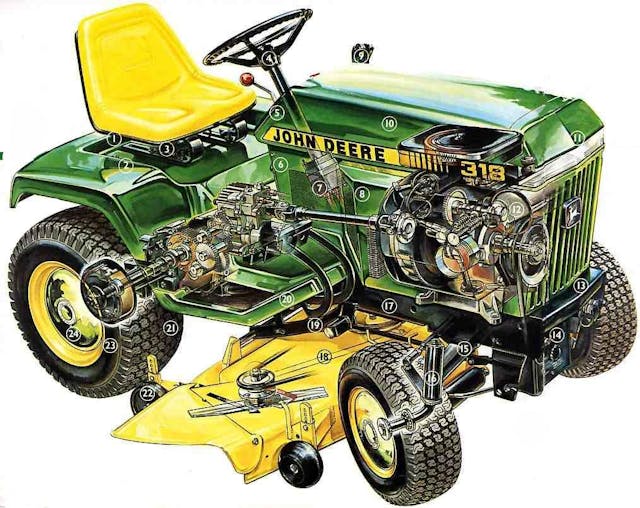
Deere was kind of a Johnny-come-lately in the garden tractor market, but today it’s recognized as the leader—and for good reason. Its 1960s- and 1970s-era garden tractors are prized by collectors and still working hard in yards and small farms all over the country.
There are over 400 different models of John Deere garden tractors. The most iconic was the 300 Series. Built between 1977 and 1992, the 300 series began with the 312 with a 12-hp single, all the way up to the 332 with a 16-hp Yanmar three-cylinder diesel.
A running and operating 300 series today can range from around $400 for a running project 312 up to somewhere around $3000 for a nicely restored or original 322 with the Yanmar diesel.
Cub Cadet
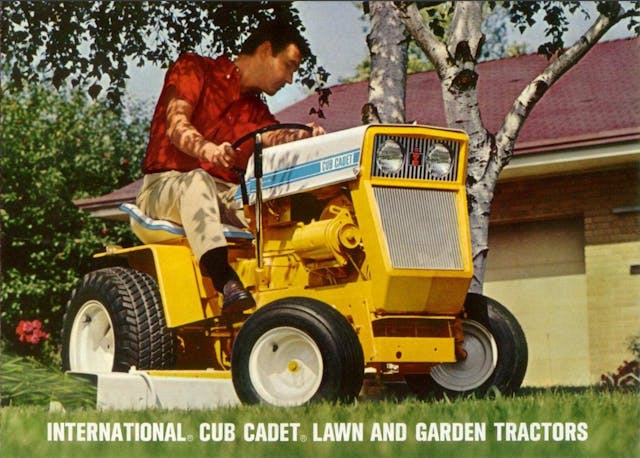
International Harvester entered the garden tractor market in 1961 with a model that’s now come to be known as the Original, a small tractor powered by a Kohler 7-hp single. Since then, there have been hundreds of Cub Cadet models, but many collectors are interested in the pre-1981 garden tractors, built when Cub Cadet was still under the International Harvester brand, before the company’s sale to MTD.
Cub Cadet’s 100 Series was produced between 1963 and 1984 and featured engines from 10hp all the way up to 16 hp. The 149— built between 1971 and 1974—is relatively plentiful, has good parts availability and has the look of a peak period garden tractor. Attachments like plows, tillers, and buckets are available. You can find a running 149 in the $500 range. Fully restored tractors would set you back $1500–$2000.
Wheel Horse
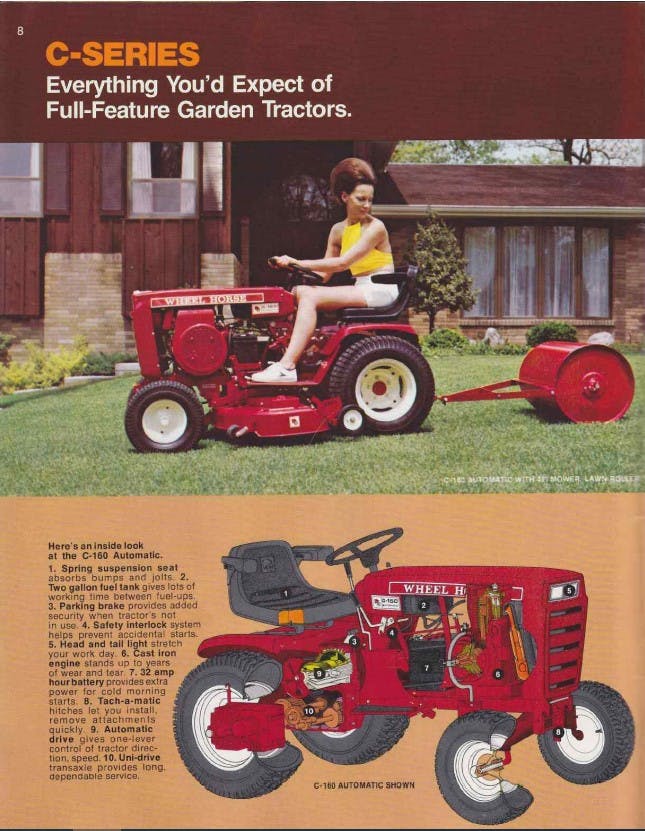
Wheel Horse arrived early in garden tractor history when Elmer Pond began building small tractors in a barn in 1946. The brand made hundreds of models over the years, but enthusiasts are particularly interested in those built before 1986, when Toro purchased the company.
Most plentiful are the C-Series tractors built between 1971 and 1984. A good example is the C-160 featuring a giant cast iron Kohler 16-hp single and a four-speed (including reverse) gear drive transmission with a low range.

The pictured C-160 was recently purchased running and fully operating for $800 including the manual angle plow and tire chains for snow plowing. A nicely restored C-160 could run into the $1500–$2000 range, especially with attachments like snowblowers and tillers. There’s even a rare hydraulic bucket attachment that could easily double the price of a good tractor.
Ford
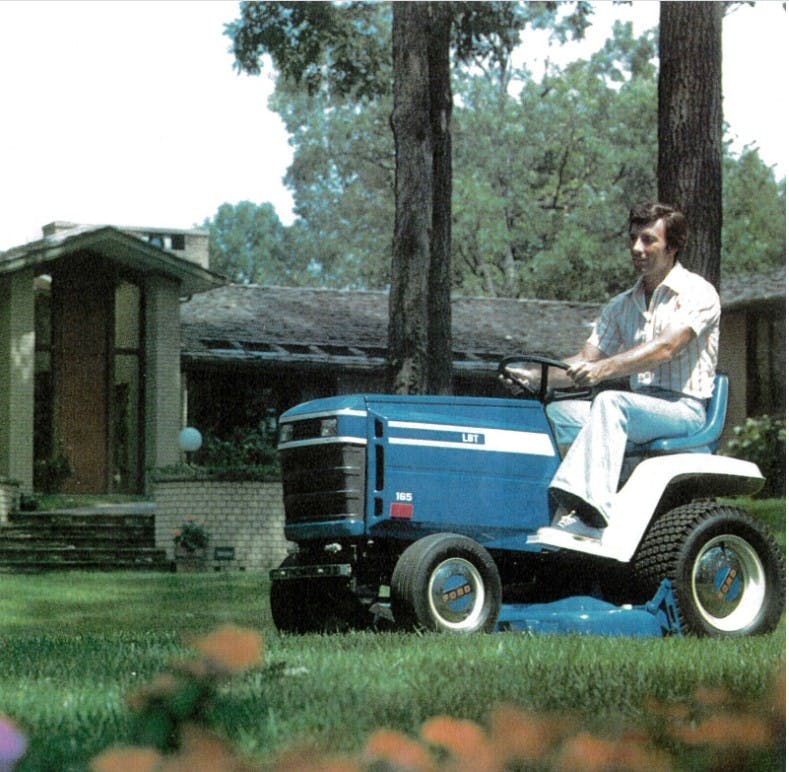
We mention Ford here mostly because the brand obviously crosses over with vintage car people and culture. Anyone with a first-gen Mustang would be proud to have a Ford LGT garden tractor in the collection. In fact, in Ford advertising the LGT 120 was referred to as the home improvement implement for “Mustang people with lawns.”
Mind you, Ford wasn’t a manufacturer of garden tractors. It contracted production out to a range of conventional garden tractor companies like Jacobsen and Toro before the brand was entirely replaced by New Holland in 1988.
Peak years for the LGT were between 1972 and 1983, with models ranging from the 12-hp LGT-12 to the 19-hp LGT-195. Depending on size and condition, you can find an LGT in the $500 range for a running and operating LGT-12, into the $1250 range for a nicely restored LGT-145.
Sears
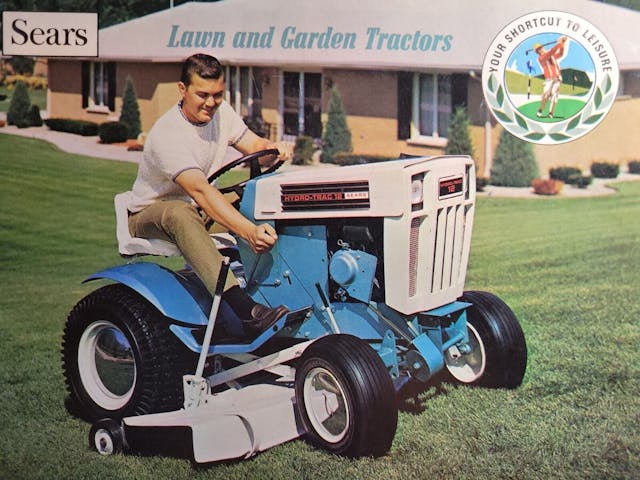
After its initial lineup of David Bradley tractors, Sears, Roebuck and Company began offering the Sears ST line of tractors in the early 1970s, before it unleashed the GT series in 1985.
Like Ford, Sears wasn’t a manufacturer of tractors, but contracted with builders of some of the best equipment available at the time. The GT series in 1985 was produced by Roper and was—at the time—a pricey $2500, featuring an 18-hp Briggs & Stratton twin and a six-speed gear-drive transmission.
At one point, these tractors were known as the Craftsman II, and they came in a variety of sizes. They’re generally regarded as tough, solid tractors with a wide range of attachments.
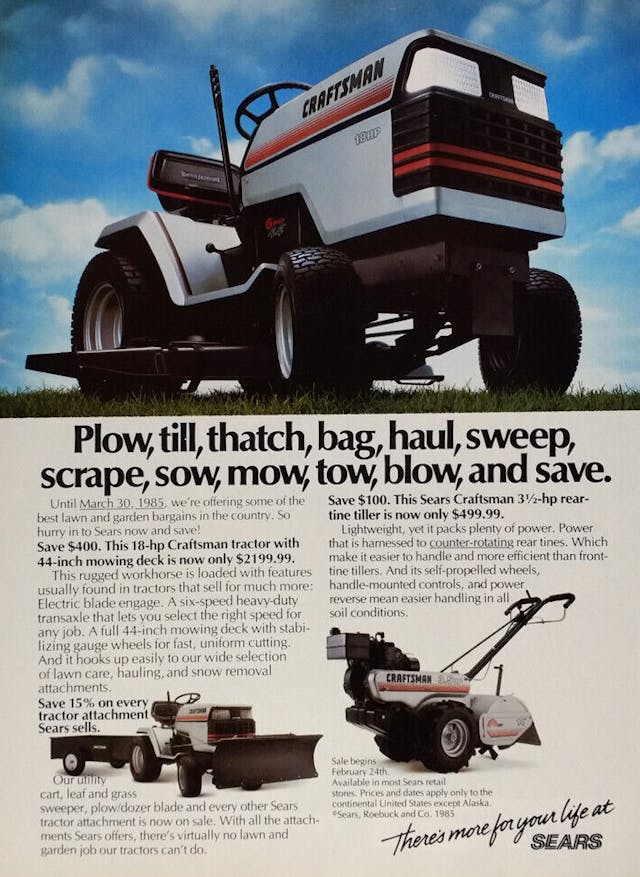
If you’re on the hunt for a Craftsman tractor, you can find a GT 18 just about anywhere in the $1000 neighborhood, depending on the condition and the attachments it comes with.
For much more detailed information on vintage garden tractors, Tractor Data has tons of information on production history. Forums and Facebook groups for every brand and variety of garden tractor are a great resource for parts, tractors for sale and DIY information. Happy riding (and wrenching)!
***
Check out the Hagerty Media homepage so you don’t miss a single story, or better yet, bookmark it. To get our best stories delivered right to your inbox, subscribe to our newsletters.


I am actively looking for a Massey that looks like the 12 HP model above. We had a 10 HP with caps and all growing up and I would love to find one like it for restoration.
As for now I have a JD that is nearing 40 years old and it still mows like new and still is reliable. I am afraid to replace it as the new tractors are not as good.
But I fear like our old Massy the lack of mower parts may become an issue. I have just started to notice some parts are becoming NA.
What about the Economy Power King? Amazing yard tractor.
I’m sure prices are regional as I don’t feel like i see any Fords, John Deeres, or Internationals in running but unrestored condition for these prices.
But this is a timely article. Just last week I saved a 1959 David Bradley Suburban, like the one in the picture, from being hauled off to scrap. It doesn’t run and needs a lot of work, but it’s complete and is an interesting looking little garden tractor. All of the levers, steering, and engine are locked up tight.
Cool article. My dad bought a 1969 JD 140 new in 1968 and still owns and uses it. When my wife and I bought our house with 2 acres, I found a 1970 and we used it for years to mow, move snow and rototill. Now we also have a 110 that I use to mow. With it’s 8 HP Kohler is quiet, sips fuel, and it’s reliable. I use the 140 in the winter for snow removal. Fortunately I also have a good friend that collects and sells parts for JD garden tractors, and after using and maintaining ours for all these years, I know them like the back of my hand. They are inexpensive, don’t take up a lot of room in the garage, and are quite handy for all kinds of work. Plus they will, for the most part, last forever.
As a member of the 8N “passionata” mentioned, most of these strike me as merely ho-hum, but I’d dearly love to get my hands on that Wheel Horse shown in the article’s title photo!
I have a couple, one is a hydro and the other is 6 speed and the other is a six speed. Have a couple of attachments. the hydro needs a restoration. Can send pic. I live in the Nashville TN area.
Another fun group of tractors is by Gravely. Huge following online with many regional meets each year. They have some seriously strong 4 wheel and 2 wheel tractors, and over a hundred implements to add to the collection or workforce.
It’s an insult to B.F. Gravely to list transmissions as “two types.” His Model-T variant epicyclic planetary system was just so good, and represents a true “third” type. And, Studebaker owned Gravely for a while. Studebaker owners like that a lot.
If you want to get into a really unique garden tractor, look for the General Electric, 36 volt, all electric machines of the early ’70s. The Elec-Trak. Using them since 1980. Awesome machines! Lots of info here https://www.myelec-traks.com
I can’t say I have seen a Ford tractor but all of these other brands I have seen somewhere in my childhood.
I have a special beast as mentioned as missing in the article. Power King Economy tractor with all kinds of attachments that needs the correct new appreciative home as my Kubota has taken over the duties of the Power King with a cab heat for winter and AC for summer. 14hp Kohler twin 3 speed transmissions and power down on the 3pt hitch. All gear driven and about the same size as an International Cub with the 8.3-24 rear tires. Amazing piece of equipment that I used for mowing the lawn moving snow in the winter and plowing ground for deer food plots and even rototilling the garden.
I have two Cub Cadets. A low three digit serial number 1961 my grandfather bought new in May of ‘61. First Cub the IH dealer received. Also have the 1967 102 my dad bought new from the same dealer in ‘67. Finally retired it from mowing duty this year.
My wife and I inherited an Allis Chalmers lawn tractor when her father ( who worked for Allis for 40 years) passed, came with a deck, snow blower and canvas cab, snow chains too. Solid unit. Then we moved to FL, not real useful so back to Indiana to another relative. I’m not an expert but AC’s seem to be rare.
Make sure to get to some antique tractor meets, to see all the bizarre configs Allis turned out on the small end of the line. Rear engine, steering column down the middle with the engine off to the side, engine centered and driver and steering hanging out. Their many forms followed their many functions!
I had a ’70s Bolens with hydrostatic drive. It was built like a tank – cast iron axle and the steering links were 3/4 inch rod. I sold it 15 years ago as it was hard start. The problem was a wire behind the flywheel that the insulation wore of. Fixed it before selling it.
big fan of the SIMPLICITY 7016h garden tractor i,ve used them the last 40 yrs very little trouble. my friend was paralized from the waist down and was able to do all his gardening on one that sold me
My shop is across the street from a dairy farm with a nice sized field where they plant corn. This one time before they planted the next crop, they had a lawn tractor plowing meet. All these fine classic tractors with tow behind implements in what looked like races from one end to the other. Very cool!
Article brings back a lot of good memories. Really enjoyed it. Inspiring me to get started with another project with my grandsons